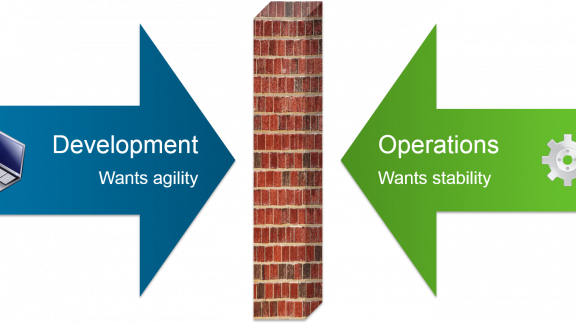One of the newest buzz words in IT organizations is “DevOps.” The principles of DevOps are contrary to how IT has traditionally managed software development and deployment. So, why are more and more organizations looking to DevOps to help them deliver IT services to customers better, cheaper and faster?
But…what exactly is DevOps anyway? It is not a job or a tool or a market segment; it’s best defined as a methodology, or an approach. It has ideological elements that are in common with techniques like Sigma Six and Lean. More on this later.
Software Development and Deployment Today
 In today’s world, there’s a “wall” between the teams that develop software and the teams that deploy software. Developers work in the “Dev” environment, which is like a sandbox where they can code, try, test, stand up servers and tear them down, as the coding work requires. Teams working in the “Ops” environment deploy the software into a production environment, where they also ensure the software is operational. Often, the developed software is literally ‘thrown over the wall’ to operations teams with little cooperation during the deployment.
In today’s world, there’s a “wall” between the teams that develop software and the teams that deploy software. Developers work in the “Dev” environment, which is like a sandbox where they can code, try, test, stand up servers and tear them down, as the coding work requires. Teams working in the “Ops” environment deploy the software into a production environment, where they also ensure the software is operational. Often, the developed software is literally ‘thrown over the wall’ to operations teams with little cooperation during the deployment.
Why Was It Set Up That Way?
This “wall” is an unintended consequence of the desire to allow developers to perform their tasks, and operational teams to do theirs. Developers are all about change; their job is to change the existing (and functional) code base to produce additional functionality. Operations teams, on the other hand, desire stability. Once the environment is stable, they would like to keep it that way, so that customers and users can do their work.
For that reason, developers usually do not even have access to the production environment. Their work—by nature—is considered too disruptive to the stability of the production environment.
The Problems with Today’s Development and Deployment
Because of the separation between developers and operations, deployment is often cumbersome and error-prone. While developers are usually asked to develop deployment techniques and scripts, these techniques first have to be adapted to the production environment. Then they have to be tested. And since the deployment teams don’t usually understand the new code (or its requirements) as well as the developers, the risk to introduce errors rises. Worst case, it will lead to incidents, which are all too common.
Additionally, in today’s datacenters that are not yet software-defined, new infrastructure—such as compute, storage or network resources—is hard to set up and integrate into the environment. This further slows down deployments and raises the possibility of disruptions to the environment.
DevOps to the Rescue
At its core, DevOps is a new way of developing and maintaining software that stresses collaboration, integration and automation. It attempts to break down the “wall” between development and operations that exists today by removing the functional separation between the teams. It uses agile development and testing methodologies, such as Scrum, and relies on virtualization and automation to migrate entire environments instead of migrating just the codebase between environments.
The main goal of implementing a DevOps approach is to improve deployment frequency—up to “continuous deployment”—of small, incremental improvements to the functionality of software. Essentially, “dot releases,” and with software updates evolving from manufactured media to online streaming, this makes complete sense.
Why DevOps? Why Now?
With the increased availability and utilization of software to provision, manage and decommission resources—such as compute, storage and network in datacenters and IT environments—the DevOps approach is becoming more and more common. IT organizations are now able to create new resources, integrate them quickly into environments, and even move them between environments with the click of a button. This allows developers to develop their code in a particular technology stack, and then easily migrate the entire stack to the production environment, without disrupting the existing environment.
Sounds Great, How Do I Start?
The three main aspects that need to be addressed to implement a DevOps approach for the development and operations of software come down to the familiar elements of project management:
- People
- Process
- Technology
On the people side, teams have to be established that have accountability over the software across its entire lifecycle. The same teams that develop the software will also assure the quality of the software and deploy the software into the production environment.
From a process perspective, an agile development methodology, such as Scrum, must be implemented to increase the frequency at which deployable packages of software are being created. Reducing the amount of change at each deployment cycle will also increase the success rate of the deployments, and reduce the number of incidents being created.
On the technology side, DevOps relies heavily on the Software-defined Datacenter (SDDC), including high levels of automation for the provisioning, management and decommissioning of datacenter resources.
VMware Is Here to Help
VMware has been the leader in providing the software to enable the SDDC. VMware also has the knowledge and technology to enable you to use DevOps principles to improve your software-based service delivery. VMware vRealize Code Stream enables continuous deployment of your software. And if you like to be on the leading edge of technology, check out VMware Photon for a technology preview of software that allows you to deploy new apps into your environments in seconds.
Kai Holthaus is a delivery manager with VMware Operations Transformation Services and is based in Oregon.





